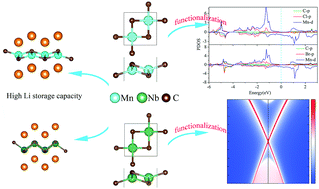Two-dimensional stable transition metal carbides (MnC and NbC) with prediction and novel functionalizations†
Abstract
In this paper, manganese carbide (MnC) and niobium carbide (NbC) are predicted as stable monolayer metallic materials, whose Young's moduli are 50.06 N m−1 and 44.07 N m−1, respectively. The ab initio molecular dynamics (AIMD) results show that both MnC and NbC could hold their structure up to 1000 K, showing favorable thermal properties. These monolayers also show good properties for promising application in Li ion batteries because of their high specific capacities and low diffusion barriers. The MnC monolayer is ferromagnetic and the Curie temperature simulated by the Monte-Carlo method is about 205 K. The electronic band of MnC shows a metal to half-metal transition by passivation of Cl or Br atoms, and the functionalization methods also cause the metallic NbC monolayer to exhibit the quantum spin Hall effect (QSHE). These novel transition metal carbide monolayers hold great promise for 2D spintronic and electronic device applications.



 Please wait while we load your content...
Please wait while we load your content...